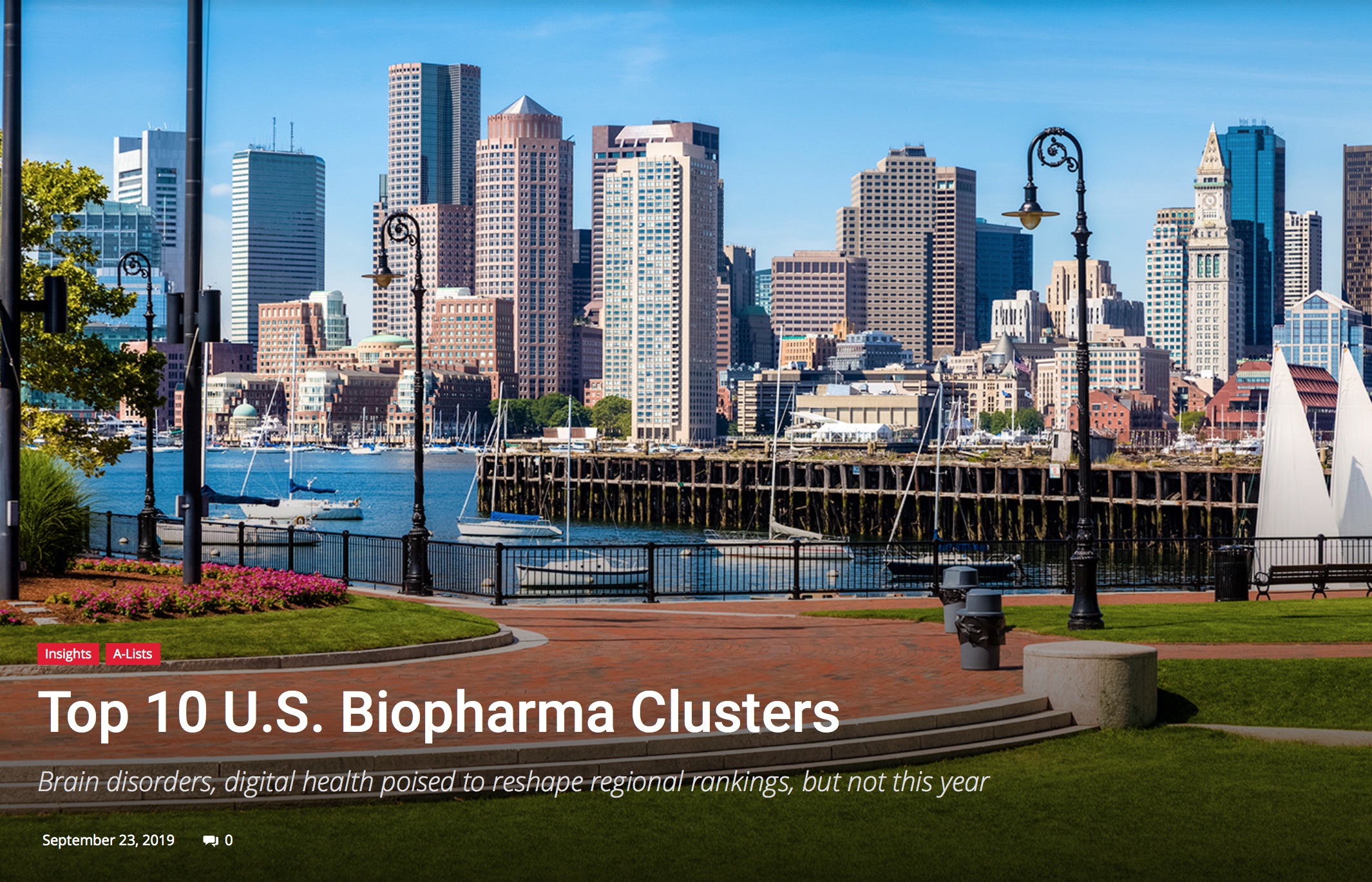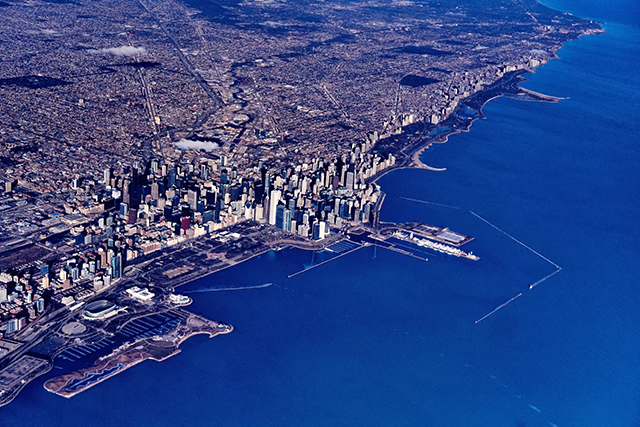September 24, 2019 I Jola Glotzer
Chicagoland moves up to #9 in 2019 GEN’s “Top 10 U.S. Biopharma Clusters” report!
Congratulations to CBC member — Northwestern University — spotlighted as a key contributor to this upward trend!
Congratulations to Northwestern University for being singled out as one of the main contributors to the Chicagoland climbing this year 1 level up among the “Top 10 U.S. Biopharma Clusters,” as reported September 23rd by GEN. Holding a position number 10 for the last several years, Chicagoland placed #9 in 2019, while Seattle dropped to #10 from #9 it held in 2018.
GEN uses several criteria to rank the regions: (1) NIH funding, (2) Venture capital (VC) funding, (3) Patents, (4) Lab space and (5) Jobs.
The Top 10 U.S. Biopharma Clusters’ standing in 2019 is:
- Boston/Cambridge
- San Francisco Bay Area
- New York/New Jersey
- BioHealth Capital Region [Maryland/Virginia/Washington, D.C.]
- San Diego
- Greater Philadelphia
- Raleigh-Durham, NC (includes Research Triangle Park, NC)
- Los Angeles/Orange County
- Chicagoland
- Seattle
Congratulations to all who made the 2019 top 10 list and to Chicagoland for advancing among the U.S. leaders!
September 23, 2019 | GEN | Insights
Top 10 U.S. Biopharma Clusters
Brain disorders, digital health poised to reshape regional rankings, but not this year

Source: Dwight Nadig / Getty Images. Courtesy of GEN.
After a generation spent shaping the growth and development of biopharma clusters, Alexandria Real Estate Equities executive chairman and founder Joel Marcus recently spoke publicly about what will most likely drive the upcoming generation of hubs for biopharma and other emerging life sciences.
“If we focus for a moment on the next life science frontier, it’s pretty clear that the sheer scale of unmet medical needs for patients suffering from diseases of the brain is quite staggering, the cost to society enormous,” Marcus told analysts on Alexandria’s quarterly conference call July 30, according to a transcript published by Seeking Alpha. He cited the growing cost of treating dementia and Alzheimer’s disease, and the nation’s opioid epidemic.
“Discovering new treatments and cures for diseases of the brain has become a goal of ever-increasing urgency and one on which Alexandria is super-laser focused on with our financial capital as well as our human capital,” Marcus said.
Marcus also emphasized the importance of thinking long-term—“Clusters take about a generation, 25 years, to really evolve and develop”—then offered a quick take on three markets where Alexandria has been especially active in recent years: “Boston, Cambridge is in there, second generation. So is San Francisco. But New York is really in the first decade.”
More recently, a top-10 cluster leader delivered some more practical insight on the science of life-sci community building. Richard Bendis of the BioHealth Capital Region (Maryland, Virginia, and Washington, DC) told BioBuzz of his six key elements to a strong, globally-competitive biocluster: Strong leadership, significant industry engagement, talent access to capital, research assets and facilities, and marketing and brand awareness.
Some of those criteria are harder to quantify than others. Not so with GEN’s annual ranging of the nation’s top 10 biopharma clusters. GEN ranks regions based on five quantifiable criteria:
- NIH funding—Taken from the publicly available NIH RePORT database, for the current federal fiscal year, from its start on October 1, 2018, through September 9, 2019.
- Venture capital (VC) funding—Taken from figures for all of 2018 and Q1 and Q2 2019, furnished by the publicly available PwC/CB Insights MoneyTree™ Report.
- Patents—Based on the number of patents containing the word “biotechnology” awarded since 1976 in namesake cities and suburbs where key companies are located.
- Lab space—Based on total-size-of-market figures, in millions of square feet, furnished by the commercial real estate company JLL in its annual U.S. Life Sciences Outlook report for 2019. Where two or more real estate companies differ widely, as occurred this year, the range is averaged, with the high and low figures reported.
- Jobs—Based on JLL’s report. While job numbers are included in the rankings, less weight had to be given to job totals in regions where GEN has found widespread discrepancies in job figures. However, workforce size was factored in when deciding the ultimate position of a region.
While this year’s A-List includes all 10 regions included on past lists stretching back to the first one in 2014, there is one twist since last year: The 2019 rankings show the No. 9 and No. 10 regions switching positions since the 2018 A-List, with this year’s No. 10 region slipping three spots from where it ranked in the 2017 A-List.
(…)
Posted below is an excerpt from the GEN’s “Top 10 U.S. Biopharma Clusters,” referring to the Chicagoland Biopharma Cluster. To read the full article CLICK HERE.
9. Chicagoland
Northwestern University attracts more than $700 million annually in federal research funding—a number it says will rise by $150 million after opening the Louis A. Simpson and Kimberly K. Querrey Biomedical Research Center on its Chicago lakefront campus June 17. The 12-story facility includes more than 625,000 square feet of research space, potential for a 16-story second phase, and more than 2,000 jobs. Also building lab space is Chicago-based Sterling Bay, which announced plans in May for a Windy City campus called Prysm Life Sciences, to include a 120,000-square-foot lab/office building, a 20,000-square-foot incubator, and access to capital. Sterling Bay also plans to develop nearby 50-acre Lincoln Yards into a mixed-use campus with early-stage and graduate research facilities; on September 16, a judge dismissed a lawsuit challenging Lincoln Yards’ planned $1.4 billion tax increment financing. One regional anchor, AbbVie, has committed to keeping its headquarters in suburban North Chicago, IL, after it completes its planned $63 billion acquisition of Allergan.
On August 2, Illinois Gov. JB Pritzker (D) enacted a five-year extension of the state’s R&D Tax Credit through December 31, 2026. Statewide industry group iBIO called for a permanent extension in its Life Sciences Economic Blueprint for Illinois. To spur job creation, Pritzker also enacted an apprenticeship tax credit covering up to $3,500 of qualified education expenses incurred by employers on behalf of a qualifying apprentice; the program is capped at $5 million per year.
Chicagoland is eighth in both jobs (50,931, according to JLL), and VC ($409 million in seven deals). Chicagoland is ninth in all other criteria, including lab space (13.9 million square feet), NIH funding (1,984 awards totaling $912.2 million, up 33% from last year), and patents (1,620).

